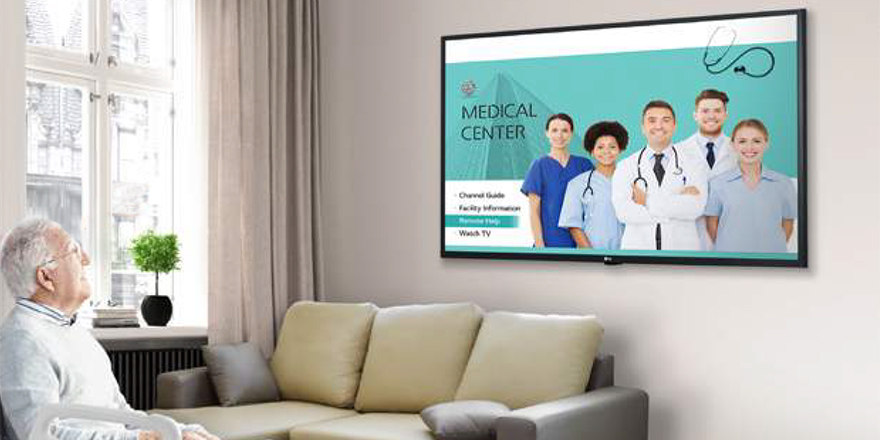
By Tom Mottlau
Director of Healthcare and Emerging Markets
LG Business Solutions USA
Hospital room TVs have become interactive portals during a patient’s stay, and smart TVs can support a variety of healthcare solutions.
Smart TVs combine a traditional TV display with a built-in computing device and network connection. “They help eliminate external TV components, so they’re easy to install in rooms,” says Dennis Mathur, Senior Vice President of Technology at Boston-based Aceso, developer of digital solutions for delivering personalized content and services to patients. “For installation, all that smart TVs need is a network connection and power. At the same time, many can integrate with important in-room devices, such as pillow speakers.”
Companies like Aceso, GetWellNetwork, MDM Healthcare, SONIFI Health, TeleHealth Services and TVR pCare have helped reinvent the patient experience using the tried-and-true television system as a healthcare portal. Their comprehensive offerings vary, but when a healthcare provider has the right information technology infrastructure in place and a network of smart TVs — securely integrated with electronic medical records (EMR) and other systems— each solution can help deliver a variety of patient amenities in support of outcomes-based care, including:
Entertainment — Today’s smart hospital TVs can deliver a variety of on-demand entertainment that people have come to expect at home, in hotels, and elsewhere, helping patients relax and potentially boosting satisfaction marks on HCAHPS surveys. And because they’re flexible, they can also support legacy entertainment systems. “If a facility only has a coax cable system, or a hybrid environment with both coax and IP, we can leverage technologies that predate smart TVs and bridge that gap between what the smart TV can do and what its predecessors were capable of,” says Bob Gruenwald, Director of Technical Operations at Los Angeles-based SONIFI Health.
Education — Because smart TVs are effectively internet devices, they’re able to reach back into hospital IT systems and software platforms to deliver educational content tailored to patients and their care plans. “Our solution is very data-driven,” says Mark Cortina, Chief Technology Officer of New York-based pCare, which offers a comprehensive interactive patient system. “By tying into the hospital systems, the pCare solution can see all the patient orders — pharmacy, radiology and others — and act intelligently. For example, as care is provided, an education intervention is triggered and content is automatically sent to the patient’s smart TV in real time.” After a patient watches suggested content, it can be automatically documented in their EMR. If they don’t watch, a message can appear on the TV encouraging the patient to take action.
There’s more to come. In the concluding Part 3 we’ll address how smart TVs can help boost patient satisfaction and comfort, provide access to hospital services and deliver a holistic, digital patient experience. See you then.